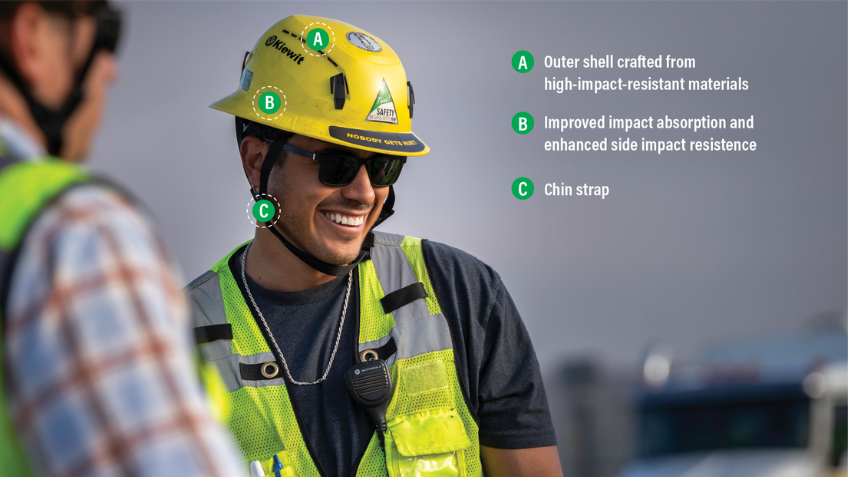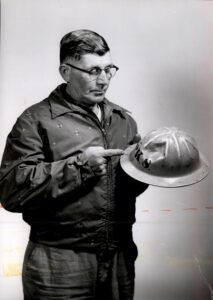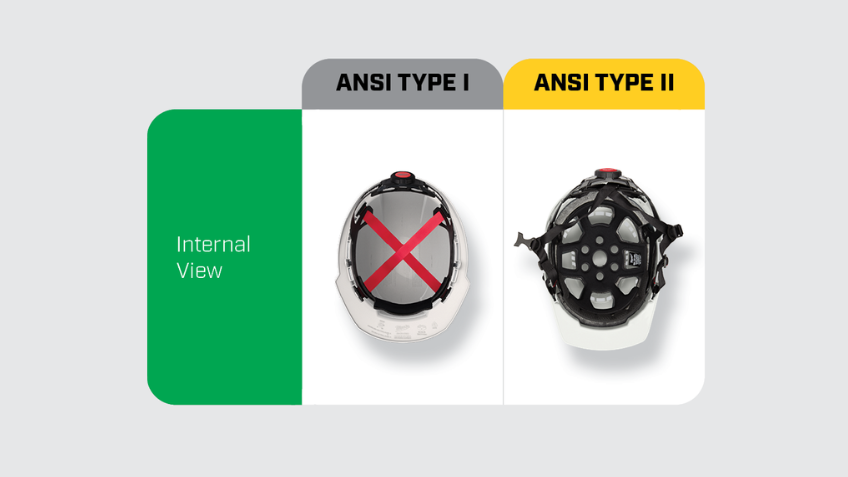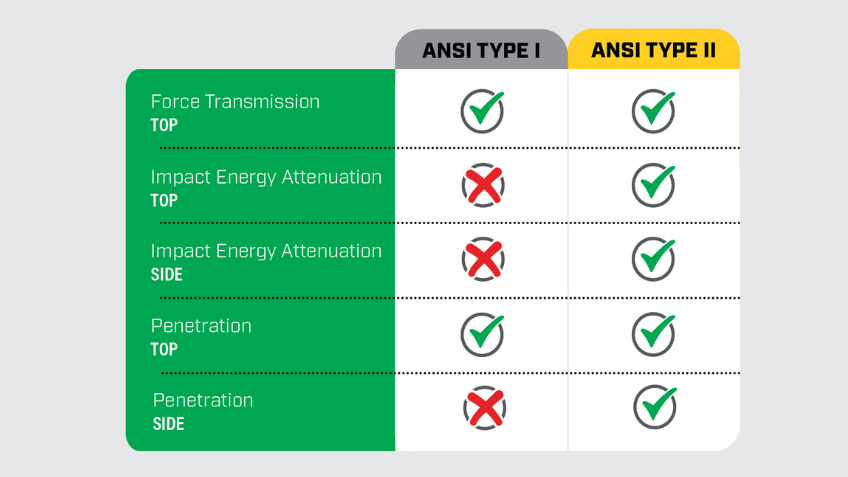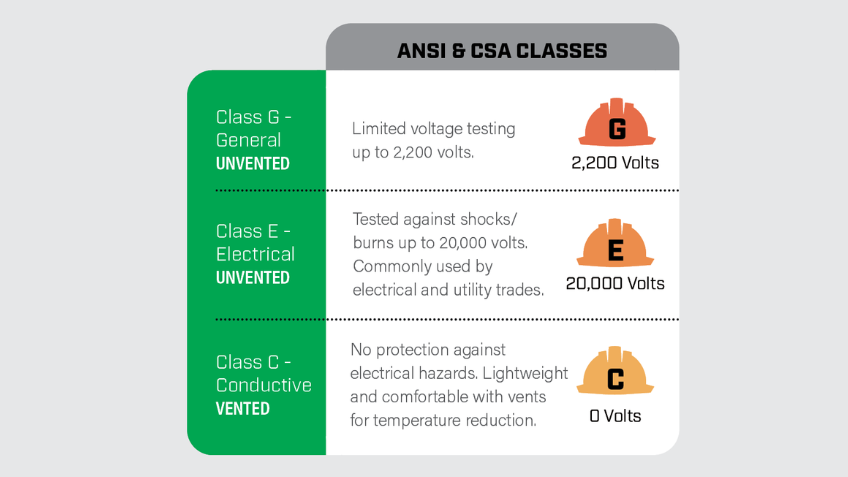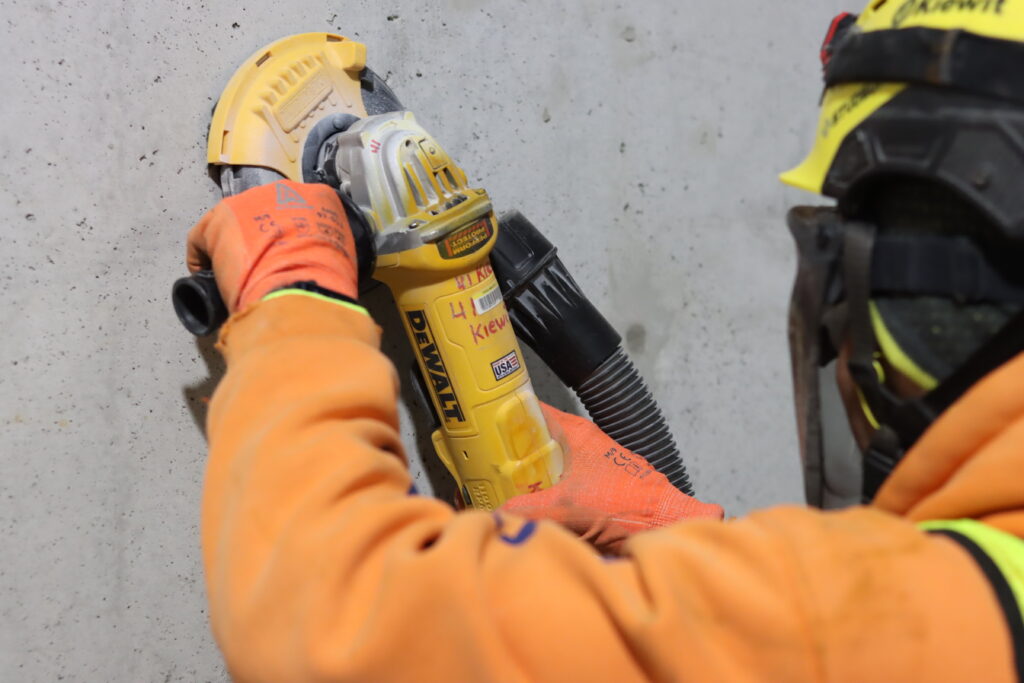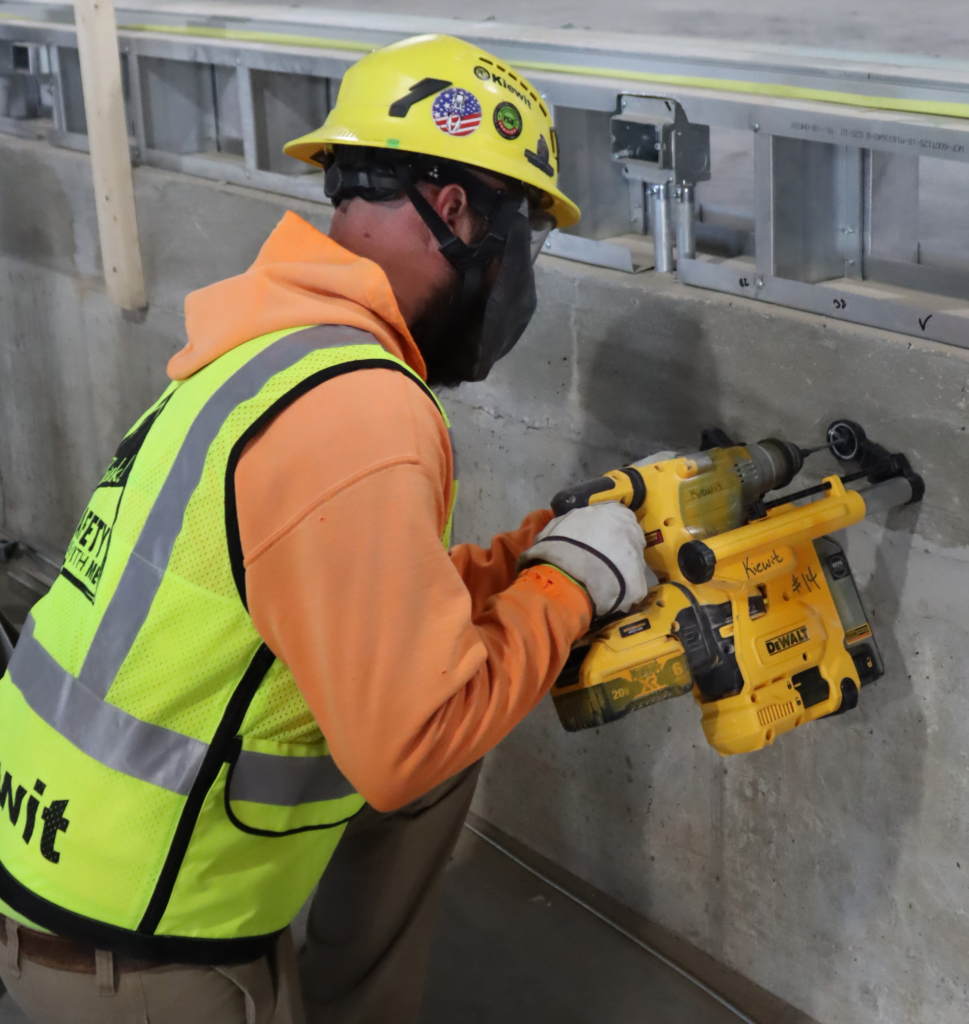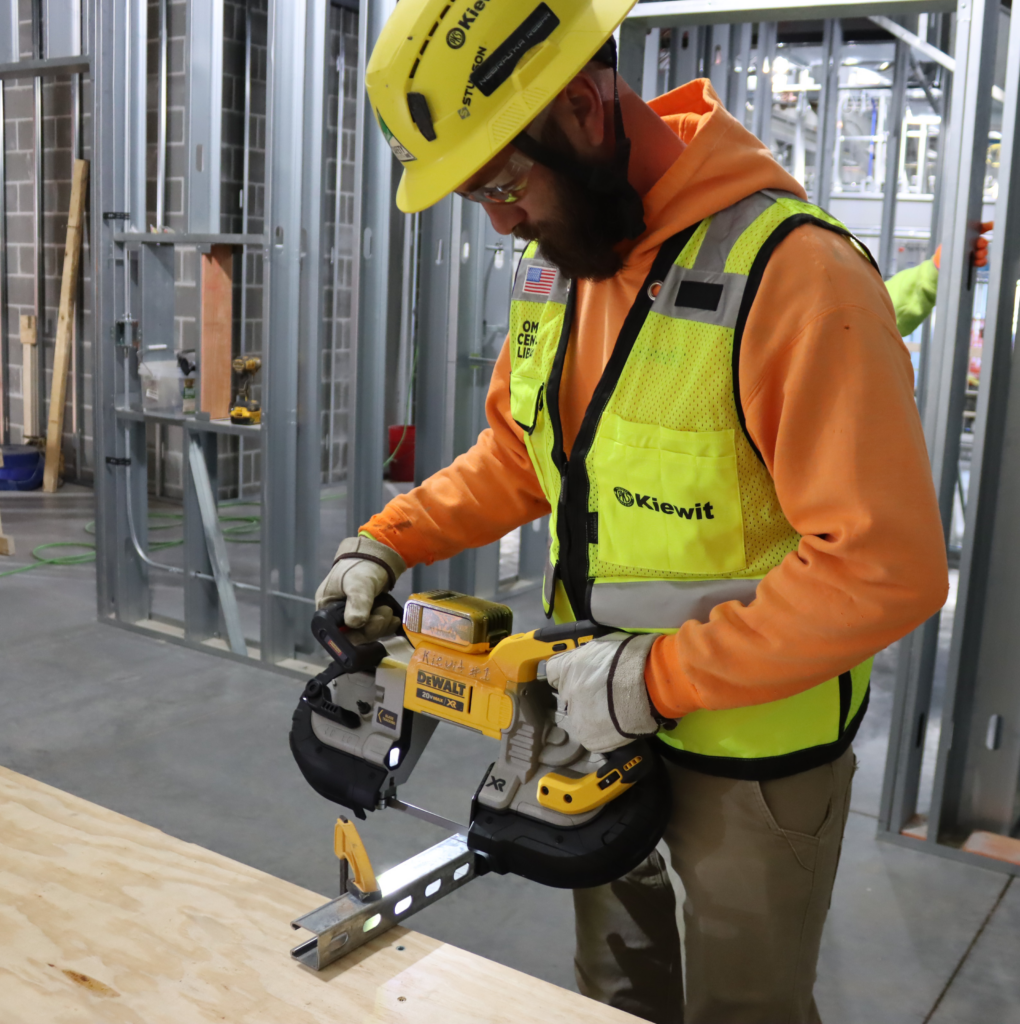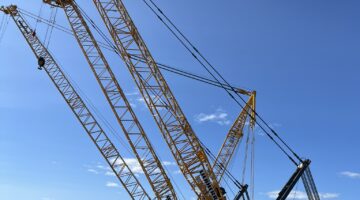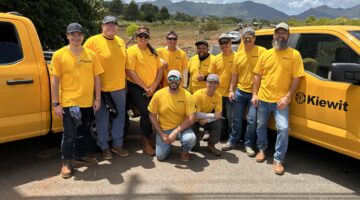Advanced helmets and injury-reducing tools are rewriting the rules of jobsite security.
Tools and hard hats are jobsite essentials, but advancements in technology are making them safer and more effective. As part of its Nobody Gets Hurt safety commitment, Kiewit is implementing these technologies to enhance worker safety and efficiency.
Safety helmets, not hard hats
Workers in the U.S. construction industry were first required to wear hard hats in 1931 during the construction of the Hoover Dam. Early models, made of aluminum, fiberglass and later plastic, were designed to protect against top-of-head impacts. In 1948, Kiewit became one of the first contractors to require the same of its workers.
Today, the hard hat remains a prominent symbol of the industry and a safety staple on jobsites. However, as technology evolves, the industry is moving away from the classic hard hat and embracing safety helmets that offer better protection. Just as Kiewit led the way in 1948, the company is once again at the forefront of adopting these new advancements.
The American National Standards Institute (ANSI) sets safety standards for personal protective equipment (PPE), including head protection, to minimize workplace hazards and injuries.
In 2024, Kiewit adopted ANSI-rated Type II safety helmets across all jobsites. These safety helmets have enhanced side impact resistance, improved impact absorption and chin straps.
“There is an obvious benefit to wearing a helmet,” said Rob Murphy, Kiewit district safety manager. “The now, better technology has led to significant improvements in safety effectiveness for workers.”
360-degree protection
ANSI-rated Type I hard hats only have to meet standards for top-of-head impacts. However, the Type II safety helmets must meet standards for top, front, back and side impacts.
John Cloutier, Kiewit project safety director, said, “It’s very compelling when you look at the reasons why we are making the shift. We take this new protection seriously.”
These helmets are engineered to absorb and dissipate an impact’s energy, from all angles, minimizing the force transmitted to the wearer’s head.
Kyle Anderson, senior project manager at Milwaukee Tool and an expert in head protection, emphasizes the importance of these advancements:
“Over a third of jobsite fatalities in the construction industry occur from slips, trips and falls causing side- or back-of-head impacts. A lot of those injuries and deaths can be prevented or limited by wearing a Type II helmet.”
Materials that matter
Type II helmets have an outer shell crafted from high-impact-resistant materials and shock-absorbing inner liners to dissipate impact force.
“Studson helmets are manufactured with acrylonitrile butadiene styrene (ABS), an impact-resistant, lightweight thermoplastic,” said Adam Bookwalter, chief revenue officer at Studson.
Much like a bicycle helmet, the inner padding of a Type II sits suspended within the helmet, giving it a higher absorption rating. Studson uses its Koroyd material in the interior of safety helmets to provide advanced energy absorption. Upon impact, Koroyd compresses instantly, effectively reducing and dissipating the force transferred to the wearer’s head.
“Koroyd is lightweight and more breathable than standard expanded polystyrene (EPS) foam,” explained Bookwalter. “Because we use a combination of Koroyd and standard EPS foam, you get a great fitting helmet that is also relatively lightweight and breathable.”
Non-conductive materials like fiberglass or plastic are used to construct the helmet’s shell. This is vital if the wearer comes in contact with live wires or equipment. ANSI-certified helmets receive an electrical resistance rating based on material and the helmet’s vents.
To customize helmets, workers can attach face shields, earmuffs, sun protection, headlamps and other accessories to aid in working under varying conditions.
These advancements have saved lives.
“We receive testimonials almost weekly about helmets preventing serious injuries,” said Anderson.
Both Milwaukee Tool and Studson emphasized the significant role that field feedback and third-party testing have played in advancing helmet technology and materials.
Securing safety
While traditional hard hats effectively protect against falling objects, they are less effective in preventing injuries from more common hazards such as trips, slips and falls.
Chin straps keep the safety helmet securely in place, reducing the risk of it being dislodged in the event of a fall or impact. This simple feature can make all the difference.
“Look at crews that work at heights or next to traffic. Essentially, if you had a serious incident where someone fell or was hit by a vehicle, their head would be unprotected because the traditional hard hat would come off,” explained Murphy.
If a worker slips and hits their head on a hard surface, a hard hat without a chin strap could be dislodged, leaving them vulnerable to injury.
“We pride ourselves on safety,” said Cloutier. “And if there is a better product out there that we should be using, that’s exactly what we will do.”
Tools that protect
Power tools are essential for many construction tasks, but they can also pose significant safety risks. Dust, vibration, tool drops, false starts and loss of tool control are common hazards that can lead to injuries and downtime. These issues not only impact worker well-being but can also slow down productivity.
“We see these common injuries time after time across the industry,” said Mike Belford, Kiewit structures manager. “We knew we needed tools designed to prevent them.”
To address these challenges, Kiewit is turning to innovative tools designed with safety at the forefront, through a close partnership with DEWALT, one of the top tool brands in the industry.
DEWALT currently produces a line they call PERFORM & PROTECT™. This system focuses on improving both worker protection and tool performance by embedding safety features into the design from the outset.
“The DEWALT PERFORM & PROTECT™ system focuses on high-performance solutions with added protection in areas like dust, vibration, control and drops,” said Frank Mannarino, president, brand partnership & customer experience at DEWALT.
One key feature is the anti-rotation system, found in DEWALT drills and grinders, which reduces the risk of wrist injuries by preventing unexpected tool rotations, such as when a drill binds up. In these instances, the tool’s rotation is automatically stopped, allowing workers to maintain better control. Similarly, grinders are equipped with both anti-rotation and braking mechanisms that stop the motor and apply a brake to the accessory when a pinch or stall is detected. This combination minimizes the risk of injury while enhancing tool control.
A particularly valuable feature in tools like band saws and grinders is the dual-activation trigger, which requires input from both hands to operate. This safety feature significantly reduces the chances of accidental starts, which can happen when a worker’s focus is momentarily diverted.
“These features stop events from happening before they turn into an injury, whether it’s an accident, a lack of knowledge or someone trying to take a shortcut,” said Belford.
Improved concrete grinders feature integrated dust shrouds and vacuum attachments, reducing airborne particles and minimizing exposure to harmful silica dust. For enhanced control and to reduce fatigue, each grinder also has an enhanced kickback brake and an anti-vibration side handle.
Similar to concrete grinders, the PERFORM & PROTECT™ rotary hammers contain a built-in dust extraction system and enhanced vibration control, allowing for the collection of dust at the source and more comfortable extended use when drilling into concrete.
When working at heights, the risk of tools or batteries falling is ever-present. DEWALT addresses this by equipping certain tools and batteries with lanyard attachment points. These points allow workers to securely tether their tools to rigid structures, preventing accidental drops that could lead to serious injury or damage.
In addition to protecting against drops, DEWALT has made strides in reducing the long-term health risks associated with tool use, particularly vibration. Prolonged vibration exposure can lead to a range of issues, from numbness, pain and increased cold sensitivity in the hands to more severe, long-term effects such as damage to nerves, muscles and joints. DEWALT’s SHOCKS Active Vibration Control™ system, integrated into rotary hammers, reduces vibration at the handle, providing greater comfort and significantly lowering the risk of vibration-related injuries.
Belford explained that these features are also making the job a bit more comfortable.
“With these integrated vibration features, employees no longer need to wear thick vibration gloves, making their work more comfortable and less cumbersome,” he said.
Dust exposure is another significant issue on construction sites, particularly during activities such as drilling, cutting and grinding concrete. This dust not only reduces visibility, increasing the risk of injury, but also poses health hazards if inhaled. Additionally, excessive dust can lead to increased maintenance needs for tools.
Workers are not the only ones at risk. During concrete grinding, third-party pedestrians near the site may also be exposed to harmful silica dust if it is not properly controlled at the source.
DEWALT’s dust extraction systems help mitigate these risks by capturing this harmful dust. This is crucial in meeting OSHA compliance standards for jobsite safety. The addition of hollow core SDS drill bits, which clean the hole while drilling, enhances the dust control process and improves productivity by eliminating additional steps.
Belford also highlighted that because these solutions are integrated into the tools directly, there are fewer pieces to haul from location to location.
These innovations — whether preventing wrist injuries, reducing vibration, minimizing dust exposure or safeguarding against dropped tools — are all essential components of a safer, more efficient work environment. By addressing these common hazards head-on, Kiewit and DEWALT are ensuring that workers and communities are better protected, not just from immediate accidents, but from long-term health risks as well. The focus on integrating safety features directly into the design of each tool means that these solutions are not only more effective, but also more convenient for workers on the ground.
As Mannarino reflected, the collaboration with Kiewit has led to significant improvements in tool safety, and it is ultimately about making a real difference on the jobsite.
“DEWALT’s mission statement is to make our users safer and more productive on the jobsite,” he said. “Partnerships with companies like Kiewit that are at the forefront of safety have pushed us to develop better solutions for those users.”
All in a day’s work
By integrating advanced safety technologies into both PPE and tools, Kiewit continues to lead the industry in safeguarding its workers. The adoption of Type II safety helmets and the partnership with DEWALT to enhance tool safety highlight the company’s dedication to reducing on-the-job injuries and long-term health risks. As the construction landscape evolves, Kiewit’s proactive approach makes sure that safety is not just a priority, but a continuous, forward-thinking commitment. With each innovation, Kiewit reaffirms its promise to provide the safest work environment possible, setting a standard for others to follow and ensuring its teams can focus on what matters most — getting the job done safely and efficiently.
